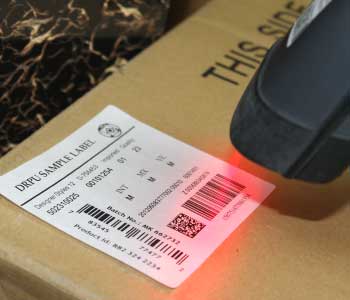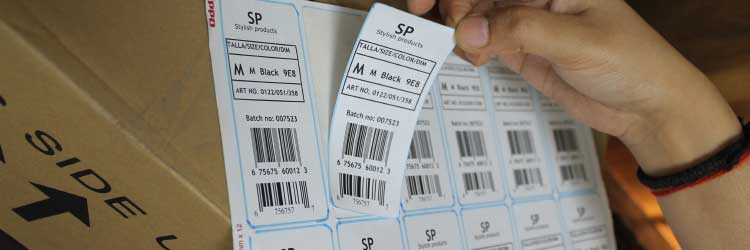Inventory Control Barcodes
Inventory control barcodes are barcodes that are used to track inventory and stock levels in a variety of industries. These barcodes work by encoding information about each item in a unique pattern of lines and spaces.
Working of Inventory Control Barcode

When a barcode scanner reads the barcode, it translates the pattern of lines and spaces into the encoded information, which can include the item's product code, description, price, and other relevant data. This information is then used to update the inventory database, allowing businesses to keep track of stock levels in real time and automate inventory management processes.
Inventory control barcodes can be printed on a variety of materials, including adhesive labels, tags, and directly onto products or packaging. They can be read by handheld scanners or integrated into automated inventory management systems.
In summary, inventory control barcodes are a key tool for businesses to accurately and efficiently manage their inventory levels, reduce stockouts and overstocking, and improve overall supply chain performance.
Benefits Of Using Inventory Control Barcodes
Using inventory control barcodes can provide several benefits for businesses, including:
Increased Efficiency
Barcode scanning technology enables businesses to automate their inventory control processes, which improves accuracy and speeds up inventory tracking and management. This saves time and reduces labor costs.
Scanning barcodes is a faster process than manual entry, allowing for faster inventory counts and replenishment.
Improved customer service
With better inventory control, businesses can more accurately fulfill orders and reduce out-of-stock situations, leading to improved customer service.
With accurate inventory tracking, businesses can ensure that they always have the products their customers need in stock, which improves customer satisfaction and loyalty.
Real-Time tracking
Barcode technology enables businesses to capture inventory data in real-time, providing real-time insights into inventory levels and stock movements. This helps businesses to make informed decisions regarding inventory management and reduces the risk of stock-outs or overstocking.
With barcode scanning, inventory levels can be tracked in real-time, allowing for more accurate and timely decision making.
Improved Accuracy
Barcode scanning eliminates the possibility of manual errors, improving the accuracy of inventory management.
Reduced cost
Barcode scanning technology reduces the need for manual data entry and paper-based record-keeping, which reduces the risk of errors and saves time and money.
Better forecasting
Real-time inventory tracking can help businesses make more informed decisions about inventory forecasting, ensuring that the right products are available when needed.
Overall, inventory barcodes can help businesses improve efficiency, accuracy, and customer service, while reducing costs and improving inventory management.
Mistakes to Avoid When Using Inventory Control Barcodes
When using inventory control barcodes, there are several common mistakes that should be avoided to ensure that the system functions properly and effectively. Here are a few examples:
1 Inadequate Barcode Labels
One of the most common mistakes is using inadequate barcode labels. If the labels are poorly designed or printed, they can be difficult to scan, leading to errors and delays in the inventory management process. Therefore, it is important to ensure that barcode labels are of high quality, properly printed, and clearly visible.
2 Incorrect Barcode Placement
It is important to ensure that the barcode labels are placed correctly and consistently, following established guidelines and best practices.
3 Failure to Test the Barcode System
Another common mistake is failing to test the barcode system before implementation. This can lead to errors and delays in the inventory management process. Therefore, it is important to test the barcode system thoroughly before deployment, to ensure that it is working as expected.
4 Lack of Employee Training
Employee training is critical to the success of any barcode system. Employees need to be properly trained on how to use the system, how to read and scan barcode labels, and how to troubleshoot any issues that may arise. Failure to provide adequate training can lead to errors, delays, and frustration among employees.
5 Failure to Update Inventory Records
Finally, it is important to ensure that inventory records are regularly updated in the barcode system. Failure to update inventory records can lead to inaccurate inventory counts, which can result in stockouts or overstocks. Therefore, it is important to ensure that inventory records are up-to-date and accurate at all times.

By avoiding these common mistakes and following established best practices, businesses and organizations can ensure that their inventory control barcode system functions properly and effectively, leading to improved efficiency, accuracy, and productivity.
Best Practices For Using Inventory Barcodes
Using inventory barcodes can help streamline inventory management processes, reduce errors, and increase efficiency. To ensure that inventory barcodes are used effectively, here are some best practices:
Standardize Barcode Labels: Use standardized barcode labels for all inventory items to ensure consistency and accuracy in scanning. The barcode label should include essential information such as the item name, SKU, and location.
Use High-Quality Barcode Labels: Use high-quality barcode labels that are durable and can withstand environmental factors such as temperature, humidity, and dust.
Ensure Barcode Quality: Ensure that the barcode labels are printed correctly and that the printer is well-maintained. Use high-quality barcode scanners that can read barcodes even if they are damaged.
Integrate Barcodes with Inventory Management System: Integrate barcode scanning with the inventory management system to ensure accurate inventory tracking and minimize errors.
Regularly Audit Inventory: Regularly audit inventory to ensure that the barcode information matches the actual inventory on hand.
Keep an Eye on Inventory Turnover: Monitor inventory turnover and adjust inventory levels accordingly to avoid overstocking or stockouts.
Establish a Barcode Management System: Establish a barcode management system to ensure that barcode labels are standardized, printed correctly, and tracked to prevent duplication or errors.
Use Mobile Barcode Scanning: Use mobile barcode scanning technology to increase flexibility and mobility in inventory management processes.
Standardize barcode format: Standardize the format of your barcodes to ensure that they can be read by all your barcode scanners. It's best to use industry-standard formats like Code 128 or Code 39.
Choose the right barcode scanner: Choose a scanner that is compatible with the type of barcodes you are using, and that can read codes from the distance and angle required by your specific application.
Label items clearly: Make sure that barcodes are placed in a visible and accessible location on the item or packaging, and that the label is durable enough to withstand typical handling and storage conditions.
Conduct regular maintenance: Regularly inspect and maintain barcode scanners to ensure that they are in good working condition. Also, replace damaged or worn barcode labels.
Keep backup systems in place: In case of a scanner failure, keep backup barcode scanners on hand, or have a manual system in place to track inventory until the scanner is repaired or replaced.
Analyze and optimize: Use the data collected from your barcode system to analyze inventory levels, identify trends and areas of improvement, and optimize your inventory management processes.
In summary, using inventory barcodes can provide several benefits but requires best practices to be used effectively. These include standardizing barcode labels, using high-quality labels, ensuring barcode quality, training staff, integrating barcodes with inventory management systems, regularly auditing inventory, monitoring inventory turnover, establishing a barcode management system, and using mobile barcode scanning technology.